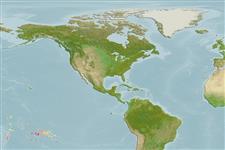Actinopterygii (ray-finned fishes) >
Perciformes (Perch-likes) >
Tripterygiidae (Triplefin blennies) > Tripterygiinae
Etymology: Enneapterygius: Greek, ennea = nine times + Greek, pterygion = little fin (Ref. 45335); randalli: Named for J.E. Randall.. More on author: Fricke.
Environment / Climate / Range
Ecology
Marine; reef-associated; depth range 0 - 27 m (Ref. 27223). Tropical, preferred ?
Eastern Central Pacific: Austral Islands, French Polynesia.
Size / Weight / Age
Maturity: Lm ? range ? - ? cm
Max length : 3.4 cm SL male/unsexed; (Ref. 54980)
Short description
Morphology | Morphometrics
Dorsal
spines
(total): 14 - 16;
Dorsal
soft rays
(total): 8-10;
Anal
spines: 1;
Anal
soft rays: 15 - 17. Short supraorbital tentacle; first dorsal fin shorter by about 50% than second dorsal fin; females dark bluish gray, bearing black double bars; back with series of pink blotches found on edges of scales; abdomen, chest, cheek, and lips pale gray with black spots; red coloration on top of head; a broad, oblique black band from eye to mouth and on chin; transparent dorsal fin bearing red rays; dusky anal and caudal fins; base of caudal black; males generally black with exception of abdomen and presence of a broad oblique band, that is light gray with black dots, on the cheek; fins colored similar as females except with more black on caudal. Dorsal rays III + XI-XIII + 8-10; lateral line interrupted, 17-21 + 14-18; mandibular pores 4-5 + 1 + 4-5 (Ref. 54980).
Adults are found in shallow depths, including intertidal pools (Ref. 27223). Eggs are hemispherical to somewhat flattened (Ref. 240, 94114).
Life cycle and mating behavior
Maturity | Reproduction | Spawning | Eggs | Fecundity | Larvae
Fricke, R., 1997. Tripterygiid fishes of the western and central Pacific, with descriptions of 15 new species, including an annotated checklist of world Tripterygiidae (Teleostei). Theses Zool. 29:1-607. (Ref. 27223)
IUCN Red List Status (Ref. 115185)
CITES (Ref. 94142)
Not Evaluated
Threat to humans
Harmless
Human uses
More information
Age/SizeGrowthLength-weightLength-lengthLength-frequenciesMorphometricsMorphologyLarvaeLarval dynamicsRecruitmentAbundance
ReferencesAquacultureAquaculture profileStrainsGeneticsAllele frequenciesHeritabilityDiseasesProcessingMass conversion
Tools
Special reports
Download XML
Internet sources
Estimates of some properties based on models
Phylogenetic diversity index (Ref.
82805): PD
50 = 0.5000 [Uniqueness, from 0.5 = low to 2.0 = high].
Bayesian length-weight: a=0.00550 (0.00251 - 0.01205), b=3.08 (2.89 - 3.27), in cm Total Length, based on LWR estimates for this (Sub)family-body shape (Ref.
93245).
Trophic Level (Ref.
69278): 3.1 ±0.3 se; Based on size and trophs of closest relatives
Resilience (Ref.
69278): High, minimum population doubling time less than 15 months (Preliminary K or Fecundity.).
Vulnerability (Ref.
59153): Low vulnerability (10 of 100) .
